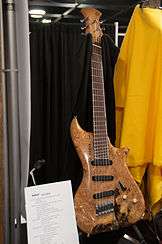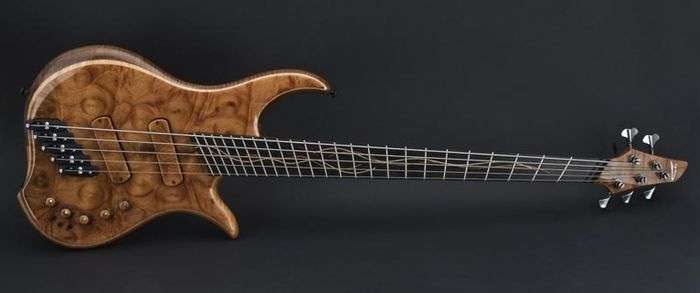Multi-scale fingerboard
A multi-scale fingerboard is an instrument fretboard which incorporates multiple scale lengths. The scale length (often simply but confusingly called the scale) is the vibrating length of the strings.
Guitars, including bass guitars, generally employ a single scale length for all of the instrument's strings, though the employed scale length varies significantly between manufacturers (electric guitar scale typically falls between 24" and 25.5"). This measure is the effective length of each of the vibrating strings, not counting compensation for adjusting intonation.
A multi-scale fingerboard or fretboard is typically based on two scale lengths, but could potentially incorporate more. The most typical use is one (long) scale length for the low string and a different, usually shorter, scale for the highest string. This could be achieved by angling the nut, and bridge, and fanning the frets. Strings between the highest and lowest would also each have a unique scale length.
History

The bandora is a late 16th century instrument with a longer string length for its bass strings than for its trebles. It is depicted in Praetorius' music dictionary Syntagma Musicum published in 1619.
The concept of the multiscale fingerboard goes back to at least 1900, when the first patent for such a fingerboard was filed by E. A. Edgren. (Patent #652-353, E. A. Edgren)
In his 1900 patent Edgren describes in his claims: “… a musical instrument the combination with a sounding body or box, of the following instrumentalities, to wit: a neck approximately in the form of a double convex in cross section…” a plurality of frets secured to said neck, said frets being positioned at an angle one to the other so that the first and last frets incline in opposite directions “... it will be noted that the bottom flange of the head C runs at an angle so that one side of the neck B will be longer than the side opposite. The frets diverge, running from the center outward, so that the lower frets extend slightly in a direction opposite to the upper frets”. This patent is no longer in force. When it was, it affected only instruments with a curved fingerboard, such as most steel-string guitars.
Possibly the first modern multiscale fretboard was used on an instrument called a StarrBoard, invented by John D. Starrett in 1977. Starrett developed a tapping instrument that employs a matrix of halftones, fretted horizontally with strings spaced vertically, to allow one fingering to cover all scales. Because of the large range of notes from low B below E on a bass, to high B four octaves above, however, he needed a way to have a long scale for the low B, but a shorter scale for the high B. He simply laid out the two scales he thought would work and connected the dots.
Fanned-fret guitar
_Fingerboard_for_a_stringed_instrument_-_drawing_1.png)

Fanned-fret guitars have multi-scale fingerboard because of "offset" frets; that is, frets that extend from the neck of the guitar at an angle. This is in contrast to the standard perpendicular arrangement of other guitars. Proponents of this style of guitar claim such benefits as comfort, better ergonomics, better intonation, and better control of the tension of the strings across the fretboard.[1]

Design and construction
Traditionally, guitars feature nineteen to twenty-four frets arranged perpendicular to the guitar’s neck. The Novak fanned fret guitar has straight frets which are aligned in a non-parallel pattern. The fanned fret guitar has an increased scale length on its bass strings when measured between the nut and the bridge. The aim of this design is to even the tone and the tension of all six strings.[3] The Novak fan-fret guitar is made of walnut and lacewood (body) and birch, maple, Padauk, or walnut laminate. Novak recommends pickups that can master a wide frequency (with wood and string tones) and as much Hi-Fi as possible. One such pickup is the Bartolini.[4]
Novak patent
In 1989, Novak patented a new type of fret arrangement that he called the “fanned fret”.[1][5] The patent has expired, but Novak holds a trademark over the term "fanned-fret".[6][7] The fanned frets create a different shape to the guitar and may allow a different performance. The slanted frets lengthen the low strings and shorten the high-pitched strings. This is achieved by placing the bridge at an angle to the nut such that the distance between the nut and bridge on the side of the fretboard for the low E string is longer than it is on the side of the high E string. There is uniform string tension across the neck of the guitar, easier adaptability to altered tuning, such as DADGAD, dropped C and dropped D, enhanced definition of harmonics, and the elimination of non-harmonic overtones and unwanted noise.[4] The B string, in particular, sounds lighter and more distinct than it does on non-fanned models. On a traditional guitar, the G string sometimes feels like it has a higher tension than the other strings; on fanned-fret guitars, the G string retains normal tension and has a somewhat warmer tone.[4]
Ralph Novak
Ralph Novak is a guitar designer, builder and repairer who brought back an old technique in the design of the fanned-fret guitar (used on stringed instruments since the origins of guitar itself). His merchandise tag was to provide an "ideal" electric guitar for blues musicians.[8][4] As a musician, he wanted an instrument that provided better tonality and prevented his fingers sliding from the end of the fret when bending the high E string.
- "“The fanned-fret idea actually started out from a very simple and very selfish notion”, says Novak. “As a blues guitar player, I liked to do a lot of note-bending, and at the same time I liked to have a crisp, crunchy sound on the low strings. My initial idea was to create a guitar that had a Les Paul-type of sustain and sweetness of the trebles and had the kind of crunch and definition of a Tele or Strat on the basses. From doing repairs for a number of years, I knew it wasn’t the construction, the stiffness of the neck, or the types of wood causing these tonal things. And it wasn’t the pickups.”[4] Novak copied an old method of fret positioning, which provides to each string its natural scale length, to achieve a better intonation on the whole string set.
Negative neck angle
Greenfield guitars has developed the 'negative neck angle' guitar. It combines elements of the concert classical guitar and the viola and mandolin (elevated fretboard). The bridge is torqued from front to back (in the direction of the lay of the strings) and from side to side. [4]
See also
- Bandora (instrument);
- Orpharion, another early modern instrument, similar to the bandora;
- Charlie Hunter, an American jazz guitarist who has performed and recorded with a “fanned-fretted”, eight-string electric guitar built by Ralph Novak;
- Jean Baudin of the band Nuclear Rabbit plays nine and eleven string bass guitars which feature fanned frets;
- Brahms guitar, an eight-string classical guitar with slanted frets, originally developed by guitarist Paul Galbraith and luthier David Rubio.
- Gordon Giltrap
References
- 1 2 "Novax guitars." Novax guitars website. Accessed 17 October 2012.
- ↑ http://www.dingwallguitars.com
- ↑ "Why fanned-frets?" Dingwall Guitars website. 25 August 2008. Accessed 16 June 2013.
- 1 2 3 4 5 6 Greenfield guitars website. Accessed 11 December 2012.
- ↑ "Patent US4852450A Fingerboard for a stringed instrument." Accessed 29 August 2013.
- ↑ "Trademark Electronic Search System (TESS)". tmsearch.uspto.gov. Retrieved 2015-10-04.
- ↑ "TESS -- Fanned Frets". tmsearch.uspto.gov. Retrieved 2015-10-04.
- ↑ "Ralph Novak." Vintage Guitars website. Accessed 17 October 2012.
External links
- United States Patent Office
- A calculator to calculate fret locations for a multiscale fretboard can be found on the Calculating Fret Positions page of the Liutaio Mottola Lutherie Information Website.